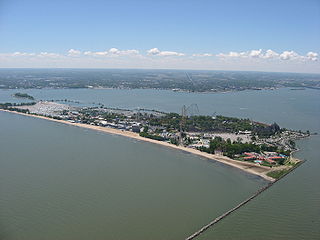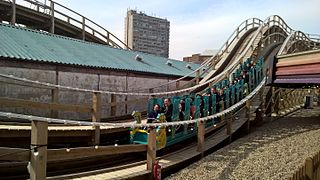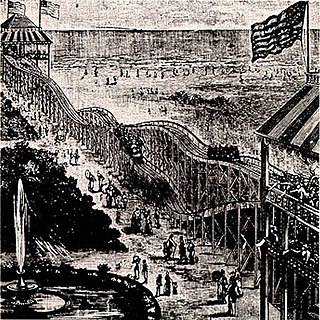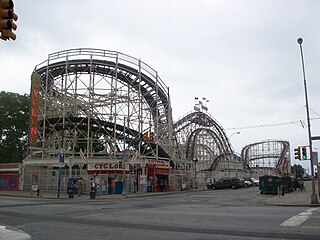
A roller coaster, or rollercoaster, is a type of amusement ride that employs a form of elevated railroad track designed with tight turns, steep slopes, and sometimes inversions. Passengers ride along the track in open cars, and the rides are often found in amusement parks and theme parks around the world. LaMarcus Adna Thompson obtained one of the first known patents for a roller coaster design in 1885, related to the Switchback Railway that opened a year earlier at Coney Island. The track in a coaster design does not necessarily have to be a complete circuit, as shuttle roller coasters demonstrate. Most roller coasters have multiple cars in which passengers sit and are restrained. Two or more cars hooked together are called a train. Some roller coasters, notably Wild Mouse roller coasters, run with single cars.

Cedar Point is a 364-acre (147 ha) amusement park located on a Lake Erie peninsula in Sandusky, Ohio, United States. Opened in 1870, it is considered the second-oldest operating amusement park in the U.S. behind Lake Compounce. Cedar Point is owned and operated by Cedar Fair and is the flagship of the amusement park chain. Known as "America's Roller Coast", the park features 15 roller coasters – fourth-most in the world with Six Flags Great America, behind Canada's Wonderland and Energylandia (17), as well as Six Flags Magic Mountain (20). Cedar Point's most recent roller coaster, Steel Vengeance, opened to the public on May 5, 2018.

LaMarcus Adna Thompson was an American inventor and businessman most famous for developing a variety of gravity rides and roller coasters.

A wooden roller coaster is a type of roller coaster classified by its wooden track, which consists of running rails made of flat steel strips mounted on laminated wood. The support structure is also typically made of wood, but may also be made of steel lattice or truss, which has no bearing on a wooden coaster's classification. The type of wood often selected in the construction of wooden coasters worldwide is southern yellow pine, which grows abundantly in the southern United States, due to its density and adherence to different forms of pressure treatment.

The Scenic Railway is a wooden roller coaster located at the Dreamland Amusement Park in Margate, United Kingdom. It first opened in 1920 and is the oldest roller coaster in the UK. The ride is distinctive compared to modern-day roller coasters, as a brakeman is still required to travel with the train to control its speed, manually applying brakes when needed. It is also one of only eight scenic railways in the world, and the UK's English Heritage granted the roller coaster Grade II listed status in 2002 and Grade II* listed status in 2011. The Scenic Railway was non-operational from 2006 until 2015 amid park closure and restoration following an arson attack.

A roller coaster train is a vehicle made up of two or more cars connected by specialized joints which transports passengers around a roller coaster's circuit. Roller coasters usually have various safety features, including specialized wheels and restraints.

Leap-The-Dips is a wooden roller coaster which is located at Lakemont Park near Altoona, Pennsylvania. Built in 1902 by the Federal Construction Company and designed by E. Joy Morris, it is the oldest operating roller coaster in the world and believed to be the last surviving side friction roller coaster of the figure-eight variety.

American Eagle is a wooden racing roller coaster located at Six Flags Great America theme park in Gurnee, Illinois. It was the first wooden roller coaster designed by Intamin of Switzerland and was built in 1981 by the contracting firm Figley-Wright at a cost of $10 million. While most of the records have since been broken, American Eagle had the longest drop and fastest speeds among wooden roller coasters when it debuted and is still recognized as a top racing coaster in the United States.

The Wild One is a wooden roller coaster at Six Flags America in Prince George's County, Maryland. It features a 450° spiral helix and a series of bunny hills that produce a significant amount of air time. The wooden coaster was previously known as Giant Coaster when it was located at Paragon Park in Hull, Massachusetts. It operated there from 1917 to 1984. It is the oldest coaster in any Six Flags park.

Lakemont Park is an amusement park located in Altoona, Pennsylvania. It houses the world's oldest-surviving roller coaster, the Leap-The-Dips. On June 19, 1996, the roller coaster was added to the list of National Historic Landmarks by the National Park Service. The park opened in 1894 as a trolley park and became an amusement park in summer 1899. It is one of only thirteen trolley parks still operating, and the 8th-oldest amusement park in the United States. The park was owned by the Boyer Candy Company from May 23, 1986, until July 1, 1988, when it was called Boyertown USA. The park was closed from 2017 to 2018, but re-opened in summer 2019. The park is located next to Peoples Natural Gas Field, home of the Altoona Curve Minor League Baseball team.

The original Switchback Railway was the first roller coaster at Coney Island in Brooklyn, New York City, and one of the earliest designed for amusement in the United States. The 1885 patent states the invention relates to the gravity double track switchback railway, which had predicated the inclined plane railway, patented in 1878 by Richard Knudsen. Coney Island's version was designed by LaMarcus Adna Thompson in 1881 and constructed in 1884. It appears Thompson based his design, at least in part, on the Mauch Chunk Switchback Railway which was a coal-mining train that had started carrying passengers as a thrill ride in 1827.

Chance Rides Manufacturing is a roller coaster and amusement ride manufacturer. The company was formed on May 16, 2002, when the former Chance Industries Inc. emerged from bankruptcy. The main office and manufacturing facility are located in Wichita, Kansas.

The Legend is a wooden roller coaster at Holiday World & Splashin' Safari in Santa Claus, Indiana, United States. It was designed and built beginning in 1999 by Custom Coasters International, with the help of designers Dennis McNulty and Larry Bill; it opened on May 6, 2000. The Legend is themed after Washington Irving's short story "The Legend of Sleepy Hollow" and mimics the frightful ride Ichabod Crane took as he was chased through the woods by the Headless Horseman. The Legend has been consistently ranked among the world's top twenty-five wooden roller coasters at the Golden Ticket Awards, which are presented annually by Amusement Today magazine.

Big Dipper is a wooden out and back roller coaster at Blackpool Pleasure Beach, Blackpool, England. Originally built in 1923, it was extended in 1936 and was designated as a Grade II listed building on 19 April 2017. It operates with two trains, each containing three four-bench cars, seating two people per bench. After Scenic Railway, Big Dipper is the second-oldest in-use rollercoaster in Britain. It has restraints of an individual lapbar and a seatbelt.

Roller coaster amusement rides have origins back to ice slides constructed in 18th-century Russia. Early technology featured sleds or wheeled carts that were sent down hills of snow reinforced by wooden supports. The technology evolved in the 19th century to feature railroad track using wheeled cars that were securely locked to the track. Newer innovations emerged in the early 20th century with side friction and underfriction technologies to allow for greater speeds and sharper turns. By the mid-to-late 20th century, these elements intensified with the introduction of steel roller coaster designs and the ability to invert riders.

On a roller coaster, the wheel assemblies are the point of contact between the cars carrying the riders and the track rails. They often consist of at least 3 wheels per assembly, but can contain more.
Toboggan is a portable roller coaster that was built by Chance Industries from 1969 to the mid-1970s. The coaster features a small vehicle, holding two people, that climbs vertically inside a hollow steel tower then spirals back down around the same tower. There is a small section of track at the base of the tower with a few small dips and two turns to bring the ride vehicle back to the station. Each vehicle has a single rubber tire with a hydraulic clutch braking system that governs the speed of the vehicle as it descends the tower. The rubber tire engages a center rail that begins halfway through the first spiral. The ride stands 45 feet tall with a track length of 450 feet. A typical ride lasts approximately 70 seconds.

A summer toboggan is an amusement or recreational ride which uses a bobsled-like sled or cart to run down a track usually built on the side of a hill. There are two main types: an Alpine coaster or mountain coaster is a type of roller coaster where the sled runs on rails and is not able to leave the track, whereas with an Alpine slide the sled simply runs on a smooth concave track usually made of metal, concrete or fiberglass. Both of these types of ride are sometimes denoted with the German name Sommerrodelbahn.
















